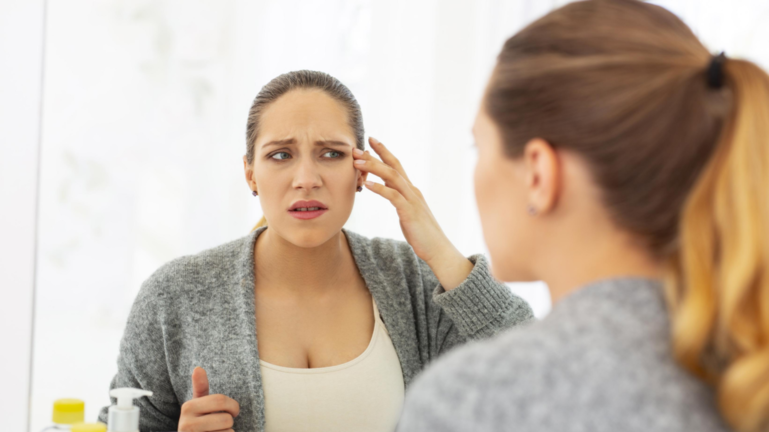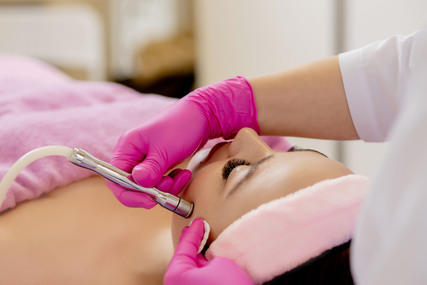Fixing Dull Skin With Your Dermatologist’s Help

Today, we just want to look more youthful and radiant. However, maintaining the glow and radiance of the skin doesn’t seem so easy for some. One look in the mirror and we don’t recognize ourselves. The reason could be dull skin. Before you panic, there are some simple ways to have your “glow” back. And it starts with a visit to your dermatologist.
What is “dull” skin?
We usually credit dull skin to mature people, but we can get pale, dry, dull skin at almost any age. Your skin sheds over 30,000 dead cells an hour. These dead cells are damaged by a harsh environment, sweat, and the natural turnover of top layer cells. Sometimes, the process may not be very efficient, resulting in skin that feels worn, rough, and missing that joie de vivre.
There are simple remedies and daily lifestyle changes to improve your skin. We will cover those later. Heading straight to your board-certified dermatologist may save you time and money. Getting sound advice from someone who knows skin inside-out is way better than trying different creams and home remedies, hoping that they work. Dermatologists have the tools and techniques in their arsenal to help fight dull skin. Here are some procedures that your doctor may do to help fix your dull skin.
Soft tissue fillers
Soft tissue fillers may be injected under the skin for various reasons such as: to decrease acne and surgical scars, fill fine vertical lines, restore hollowed cheeks and eyes, and so on. Some fillers contain beads of solid materials suspended in gel. As the gel gets absorbed, the droplets will form a scaffold for collagen growth. You may also opt for fillers containing hyaluronic acid to fill the lines and wrinkles on your skin as well as add volume to it. The hyaluronic acid “refills” the sugar that naturally occurs on your skin, which you lose as you age. This hyaluronic acid filler injection can last for six months to a year.
Chemical peels
Chemical peels can remove the outer layers of your skin to make room for the growth of new and smoother skin. The peel’s intensity may vary – from superficial to deep – depending on the skin problem that you would want to address. The effects and benefits of a superficial peel may last for a month while deep peels may last for a few years. Also, since the skin will be peeled off, expect to see some reddening on the area of peeling. Chemical peels are an excellent way to reset for dull skin, giving you a second chance to take care of your skin and maintain your glow.
Microdermabrasion

With microdermabrasion, your dermatologist uses a small device to scrub away dead, uneven skin. There are a few techniques, including crystal, diamond tip, and Hydradermabrasion. Like chemical peels, this treatment also removes cells from the outer layer of your skin so that new skin will grow. It may be quite uncomfortable, especially for first-timers, but it’s not painful. What makes microdermabrasion amazing is its quick recovery time and ability to stimulate collagen growth. You may need multiple procedures for a few weeks to see the best results. However, the effects of microdermabrasion last for only three to five days.
Microneedling
For this procedure, the dermatologist uses either a battery-operated or an advanced electric instrument that has tiny, sharp needles. But don’t worry, it is not as painful as you would imagine. Instead, these needles would only cause injuries just small enough to trigger your skin to produce collagen and elastin. Your dermatologist may have an RF Microneedling device, providing more in-depth treatment using radiofrequency waves. Also, some opt to add therapeutic substances like the hyaluronic acid or ascorbic acid before or after the needling procedure so that the chosen material would penetrate deeply. Many prefer this procedure since it is risk-free and can rejuvenate your dull skin.
Consider laser therapy

Another treatment that you may also ask from your dermatologist is laser therapy. This kind of procedure uses high-intensity light. The light, through the laser, is then focused on small spots and applied with high energy. There are two general types of lasers – the Ablative and Non-Ablative Lasers.
Ablative Lasers
This type of laser procedure ejects an intense light wavelength unto the skin to remove its outer layers. The laser then triggers the underlying skin to form collagen. After such, an ointment or a type of dressing is being applied to the skin. When the skin heals, the newly-formed skin is expected to be smoother and tighter.
Non-Ablative Lasers
Unlike the ablative lasers that deal with the outer layers of the skin, non-ablative lasers target the underlying skin to directly stimulate collagen growth and tighten the skin. It can also remove fine lines as well as treat mild to moderate skin damage.
Dermatologist treatment is just the start.
Your dermatologist can give you the headstart you need to reduce wrinkles, dryness, and dull skin. You’ll feel amazing at first, but your skin can easily go back to square one. To see the best results, you’ll need to start adopting better health and lifestyle habits consistently.
Stay hydrated

Dehydration is one of the primary reasons your skin isn’t looking the way you remember. It decreases the volume of blood flow to the skin. Worse, being frequently dehydrated can cause long-term skin problems such as sagging skin, fine lines, scales, and deep wrinkles. As we get older, we tend to go longer without water, simply because we don’t feel thirsty. In a 2018 survey, more than 77% of Americans believed they did not drink enough water. Get your water intake up to at least eight glasses a day, especially after dermatologist treatment.
Make sleep a priority.

While we’re sleeping, our body is in repair mode. During that reset, our skin cells are regenerating. Poor sleep quality and short sleep times throw everything out of sync. As little as 1-2 nights of poor sleep can give you pale skin, dark circles under the eyes, and extra wrinkles. The solution is to sleep for seven to nine hours if you want to keep your skin fresh and healthy. You may also apply some night creams or an overnight mask to increase the moisture of your skin.
Put in some exercise!

Yes, you read that right. Even exercising can help maintain the glow of your skin. Aerobic activities improve your blood circulation. As such, it helps the skin absorb the nutrients and remove toxins from the skin cells. Whether at a gym or in your own home, a workout routine can cause a massive difference in your skin in the long run. Don’t forget to shower soon after to wash away the sweat and dirt! And of course, it’s also good for your physical wellbeing.
Have a healthy diet

What does food have to do with your skin? More than you think. First, salty and processed foods cause fluid retention. Fluid retention causes swelling of tissues, which is one of the reasons why you have dull skin. High sugar and fat intake also contribute to your skin’s health. Instead of these types of foods, switch to antioxidant-rich foods such as blueberries, cranberries, beans, and leafy greens. Foods with good fats like walnuts and avocados are also recommended. Then, there are also citrus fruits that contain vitamin C that is not only good for your immune system but also stimulates collagen growth.
Kill the stress

It’s difficult to be stress-free, especially in a challenging year like 2020. At the same time, stress is a huge factor in the appearance of your skin. More stress means more cortisol, the “fight-or-flight” hormone. Too much cortisol can harm your immune system and sends signals to your skin to produce more oil. This can lead to acne, a lack of water retention, and dull skin. Spend some time improving your mindfulness, being more relaxed, and you’ll see a change in your skin.
Step up your at-home skincare game

We wouldn’t be doing our job if we didn’t talk about a skincare routine! Your dermatologist may have fantastic skin, but it takes daily effort through a skin care regimen. Start your skin health off in the shower with a wash that does not strip excess oils. Then add a moisturizer, serum (with Vitamin C), and sunscreen. At night, make sure to remove all makeup and dirt with a cleanser. Speak with your dermatologist for the best products based on your skin type.
Let’s help you restore your glowing skin.
With dermatologist help, these procedures can transform your dull skin. However, as the cliche goes, “prevention is better than cure.” These treatments should be part of a larger goal to maintain healthy skin through proper care, health, and wellness.
Schedule an appointment for a consultation
For expert consultation, contact us or book an appointment online now. Our lead physician, Dr. Ife J. Rodney MD, FAAD, is a trusted medical, cosmetic, and surgical dermatologist in Maryland. We are conveniently located in Fulton and serve Columbia MD, Clarksville, Ellicott City, Laurel, Bowie, Silver Spring, and surrounding areas in PG and Howard County, Maryland.
RELATED CONTENT
Microneedling Specialist Columbia MD
